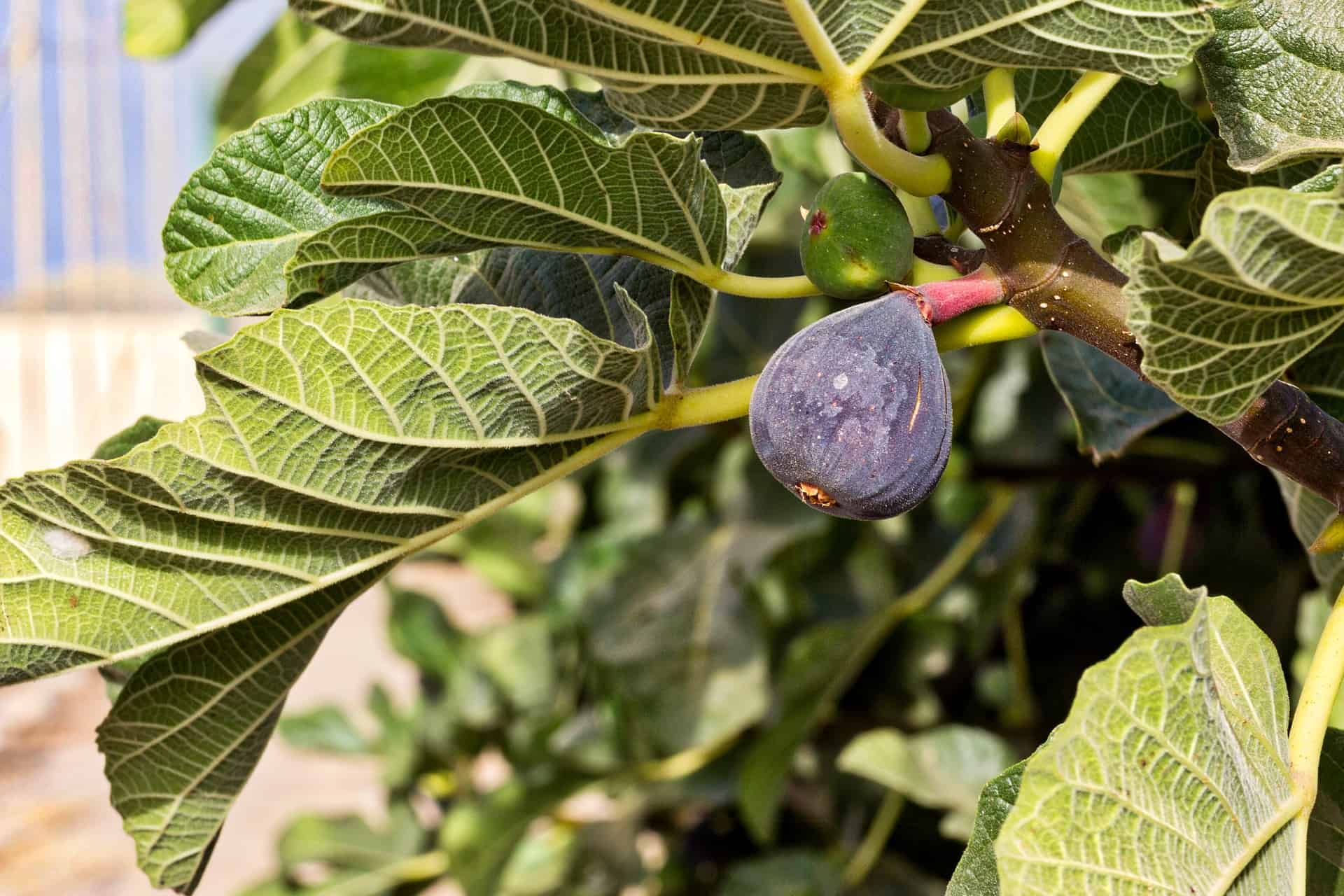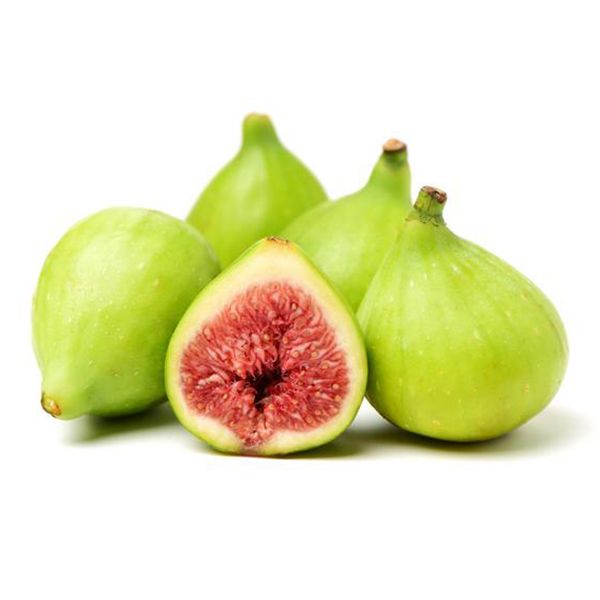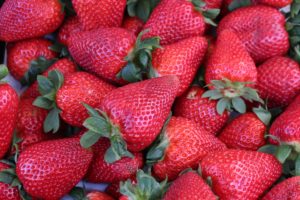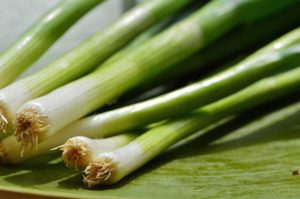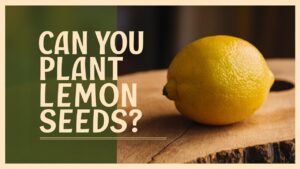There are lots of different Fig Tree Varieties that you can grow in your garden. You can even find some cold-hardy types of figs in this list if you live in an area that experiences freezing winters.
All the fig trees on this list have a wonderful flavor, but keep reading the article to the end because the last fig variety puts all the others to shame.
Fig Tree Varieties
Black Mission Fig Tree

Black Mission Fig Tree – (View Price)
Black Mission Fig Tree (Ficus carica ‘Mission’). This prolific tree produces two harvests each year. How nice to be able to run outside and harvest incredibly fresh figs for snacking, baking, and more from your very own tree! You’ll know exactly how your food was cared for over many productive years. Growers love this Fig variety for its easy-care nature. Plant it in the ground in warmer Zones where the climate is cooperative. Or, plant your Black Mission Fig in a container in colder Zones.
The Black Mission Fig variety requires minimal upkeep. You don’t need to have a green thumb to grow this tree. They don’t require a lot of fuss to keep them looking and performing their best. Just plant it in well-drained soil, provide even watering and watch the magic unfold. Known as one of the most abundant Fig species, the Black Mission Fig Tree produces year after year. It’s a wonderful choice, with sweet, jammy fruit bursting with flavor.
You’ll be glad to hear that Black Mission Fig starts producing faster than many other Fig or fruit varieties. This means that you can enjoy a bountiful harvest in just a few years. It’s a treat to harvest two crops of figs a year. Whet your appetite with the early Breba crop on last year’s wood, Watch for the main crop in the fall from the tree’s new growth. Enjoy the many ways to enjoy the luscious fruit from your Black Mission Fig.
Celeste Fig Tree
Celeste Fig (Ficus carica ‘Celestial’) is one of the most widely planted Fig trees in the United States and with good reason. This Fig tree produces such sweet and delicious fruit that it often goes by its nickname, the “Sugar Fig”. It earns its nickname each summer with scrumptiously sweet fruit that has a rich, buttery-smooth flavor and texture. The fruit is not only delicious – it’s beautiful, too. The fruit features edible, violet skin and rose-colored, strawberry-like flesh inside.
Celeste Figs can be eaten fresh for a delightful treat. No need to peel, you can eat the skin and all! The fruit also dries perfectly for long-term storage and easy snacking. The tree itself makes an impressive specimen. You’ll love the distinctive, deep-green lobed Fig leaves that grace the tree all summer long. The leaves have such a wonderful, tropical shape and the branches have a nice-looking structure.
Celeste Fig is one of the easiest fruit trees you can grow. Here’s why: It’s a self-pollinating tree, so you only need one tree. It’s a medium-sized tree that doesn’t need a lot of pruning. It will stay small enough for you to easily harvest your crop. This is a ‘closed-eye’ variety, which means the little eye on the bottom of the fruit stays tight. This helps it resist pests, splitting, and souring. This is especially welcome in those long, humid summers of the Deep South. Celeste Fig is disease resistant. It’s also heat tolerant, versatile and adapts beautifully to most climates.
Well known to be a vigorous grower in the more humid climates of the South, Celeste shows itself to be a more compact grower in the drier climates of the Western and Southwestern United States. This tree produces well in coastal areas. It even performs well in large containers.
Peter’s Honey Fig Tree

Peter’s Honey Fig Tree (View Price)
Peter’s Honey Fig produces very sweet, shiny, high quality, and greenish-yellow fruit when ripe. The fruit tastes syrupy and honey-like. This fig will melt in your mouth! Peter’s Honey Fig is superb for fresh eating. These figs can be used for drying and canning too.
It has good cold tolerance, but it requires a warm location with a southern exposure to ripen, especially in the maritime Northwest. In other words, it requires a sunny, hot exposure in cooler areas. If a fig is killed to the ground because of cold weather, it will come up with new growth when the weather warms up. An excellent way to get figs to produce ripe fruit in colder climates is to plant potted figs when the weather warms up.
Plant the pot with the rim a few inches above ground level. Roots will go through the drain holes at the bottom of the pot and produce nutrients for the plant. When the leaves fall in late fall, dig the pot up and store inside. Replant again next spring. This tree thrives in full sun and in the South it ripens its first crop in May and a later crop in October and November. Peter’s Honey Fig originated in Sicily. Cold Tolerant Greenish Yellow Fruit Very Sweet Honey Flavor
Chicago Hardy Fig Tree

Chicago Hardy Fig Tree (View Price)
Chicago Hardy Fig Tree (Ficus carica) makes an awesome addition to any yard and as its name implies, this tree originated in Chicago. This makes it an ideally suited Fig tree for northern landscapes. It’s not just a cold-hardy Fig, it is great-tasting as well. It is for this reason that the Chicago Hardy has become one of the favorites of home gardeners around the country.
Chicago Hardy Fig can produce up to 100 pints of Fig fruit per season and are easily grown and maintained. While it thrives outdoors, this Fig tree will even succeed when potted and brought inside during the colder season. Chicago Hardy Fig Trees, which prefer full or partial sun, are high-yielding, self-fruiting, and ever so easy to grow.
Read More: Best Fertilizer for a Potted Fig Tree
They produce medium-sized, purple-skinned Figs that are delicious when peeled and eaten fresh from the tree. Figs typically ripen anywhere from August until the first frost in the fall, but the tree may even bear fruit as early as July. There’s no need to wait for them to produce as this easy-to-grow tree will usually bear fruit in its very first season.
In some colder climates, the tree can freeze to the ground. Don’t be alarmed when this happens, though, as it will come back in the spring and will even produce fruit that same year. Because the Chicago Hardy Fig fruits on new wood, this cycle does not affect its fruiting at all.
The wide range of adaptation means that this tree can thrive in Zones 5-11, from the hot climates of central California to various coastal climates around the country. Because of its small to closed eye, Chicago Hardy is a good choice to plant in Texas as well as all along the Southern Seaboard. And of course, those hungry gardeners in Zone 5 finally get a chance to grow delicious Figs for themselves!
This Fig is an attractive upright shrub or small tree, with distinctively large and leathery, dark green three-fingered leaves. Also known as Bensonhurst Purple,’ Chicago Hardy Fig Trees may be pruned to control its size. Chicago Hardy Figs do well as container-grown trees and are drought-tolerant once established.
Black Jack Fig Tree

Black Jack Fig Tree (View Price)
Black Jack Fig (Ficus carica ‘Black Jack’) produces large, elongated purplish fruit that hangs in clusters. The flesh of the Black Jack Fig is strawberry red, super juicy, and succulently sweet. A lover of full sun, the Black Jack Fig starts green before turning to the telltale rich purple before it’s ready for harvest.
The taste of the Black Jack is phenomenal, which is why it is often eaten fresh, right from the tree. Some growers make these Figs into preserves. They’re also great dried, which is a good way to preserve a large yield so that you can enjoy them all year long. The Black Jack is an overachiever by any standards, producing bushels of Figs from mid-summer through September.
It is a dwarf, so it is naturally small, making it a great choice for landscapes where space comes at a premium. For Fig enthusiasts living in colder climates, the Black Jack is highly adaptable to container growth, just bring it inside when the mercury starts to plummet. Black Jack Fig is a wonderful addition to any yard, patio, or balcony.
Violette de Bordeaux Fig Tree

Violette de Bordeaux Fig Tree (View Price)
The Violette de Bordeaux Fig Tree (Ficus carica) is also known as the Negronne Fig. Violette de Bordeaux is considered by experts as one of the best figs because it has an irresistible fragrance and a fantastic sweet, rich flavor. It produces small to medium size blackish-purple fruit, with the darkest strawberry-red flesh of any fig.
Violette de Bordeaux is considered the finest tasting of all figs and can be enjoyed fresh or dried. One of the biggest bonuses of this very heavy fruit tree is that it can give you two crops of juicy figs a year. The Violet de Bordeaux is a natural dwarf tree. Its size makes it perfect as an accent tree for a small space. It is by far one of the first choices for those desiring to grow a fig in a container on a patio or deck.
Violette de Bordeaux will thrive in extreme heat, humidity, and drought, and the tree has very good resistance to pests and disease. You and your family will love the Violette de Bordeaux and this variety’s endless possibilities. Eat fresh picked right off the tree or spread ripe fruit on toast for a fast and healthy breakfast. Some say it is the best jam they’ve ever had.
Panache Tiger Fig Tree
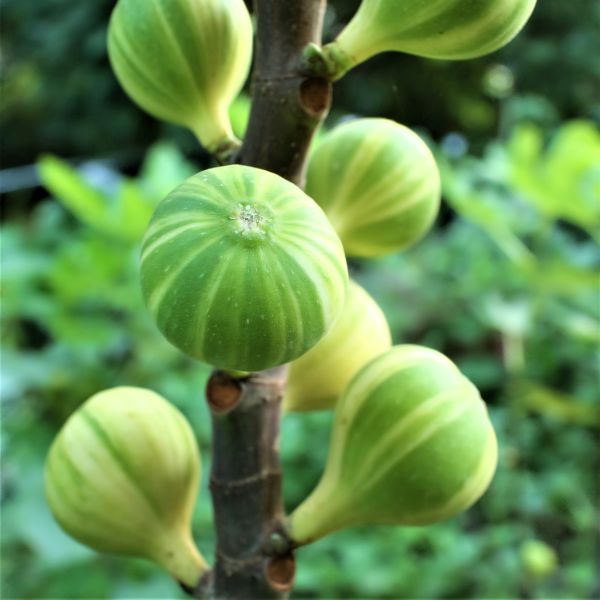
Panache Tiger Fig Tree (View Price)
Why does the Panache Tiger Fig Tree (Ficus carica ‘Panache Tiger’) have so much… well… panache? It could be because its figs are prized for their flavor and beauty or because it is one of the most reliable producers. Either way, this self-fruiting fig tree is one of the best you will find for warmer regions. Known for its tiger-striped figs, this fig tree is one of the most striking varieties available.
Its figs arrive late in the season and ripen by August or September. These figs are dressed for the party. They adorn themselves with bright green and yellow to cream variegated stripes that show off their juicy curves. And as they ripen, they celebrate the occasion with a wardrobe change from stripes to solid yellow then a finale of verdant green. With blazing red insides, these figs are just as beautiful as they are delectable!
How does the Panache Tiger Fig Tree’s fruit compare to other cultivars? Aside from their amazing pattern, they are perfect for eating freshly picked. Panache figs are slightly more subtle in sugar levels and flavor which makes them ideal for growers that prefer lightly sweet fruits rather than heavy sugars. They are also considered more petite than other figs. And this variety produces more figs annually than many others. Panache Tiger Figs are ideal for adding to fresh and vibrant salads for a hint of sweetness or as a topping for yogurt or ice cream. They also make great preserves when combined with other fruits.
While the Panache Tiger Fig Tree’s figs is dazzling, so is the overall tree. This specimen features large, deep green glossy leaves and lightly stripped branches. Plant your Panache Tiger Fig Tree among your fruit tree collection in your backyard or front yard. Its easy-to-manage size makes it ideal as a screen beside your fence or side yard. The more sun it receives, the sweeter and more plentiful your harvest will be. Provide this deciduous wonder with plenty of sun. It adapts well to a wide range of soil types and only needs additional water during the hottest times of the year. It will begin producing figs within two to three years after planting and does best with 100 chill hours.
Excel Fig Tree
The Excel Fig Tree (Ficus carica ‘Excel’) is widely regarded as the best yellow fig, the Excel truly lives up to its name. This fig variety produces large yellow fruit with high sugar levels late in the season. When ripe, they turn greenish golden yellow and often feature freckles of sugar concentration. With a medium closed eye, these are some of the sweetest figs you will find.
When you cut into Excel Figs you are gifted with syrupy amber flesh that you won’t be able to resist. Excel Figs are self-fruiting and ripen well on the tree. They don’t crack readily, allowing them to get plenty of time to sweeten in the sun. This crop is a late-season crop, making it easy to attend to with other fruiting trees, yet it’s earlier than other Breba varieties.
This deciduous tree is easy to prune and trim to keep petite if you choose. And with large vivid green leaves with three deep lobes and shiny gray bark, the Excel Fig Tree makes an excellent container specimen. The Excel Fig Tree is a wonderful edible landscaping tree as well. It will add a lush touch to your yard and attract birds. If you don’t want to share your harvest, plant yours in a fenced-in area, and try netting.
To keep your Excel Fig Tree excelling, plant it where it can revel in the sunshine and produce some of the sweetest figs you’ll ever try. It does well in many different soil types from clay to sandy soils and doesn’t require a lot of watering. Is your landscape excellent? If so, you deserve one of the best fig trees known for its beauty and refinement. Create a paradise of figs with the self-fruiting Excel Fig Tree.
Olympian Fig Tree
There is nothing so luscious as a tree-ripe fig, and there is hardly a crop easier to grow at home! Nothing you’ve had at the store can even compare. One of the most sought-after and award-winning Figs is the Olympian Fig (Ficus carica ‘Olympian’) trees to your Edible Landscape. You’ll enjoy harvests two times a year.
People rave about the sweet taste of Olympian Fig fruit. The fun, green and purple-striped skin is thin and easy to prep. Its yummy, succulent flesh is a beautiful violet shade!
Olympian Fig features an early Breba crop that arrives from late spring to early summer! You’ll want to host an annual party in early fall. Get some help getting your fully ripened main crop harvested. Pick your ripe figs when the texture starts to soften up. Gently tug upward and it should come off easily, when ripe.
Fresh figs sweeten up the taste of many dishes, from savory meats to desserts. Go ahead and add them to smoothies with bananas. Start gathering artisan recipes of figgy deserts. These small powerhouses contain a lot of healthy micronutrients; in addition to a wonderful amount of delicious, natural fructose. Enjoy them fresh on a cheese plate. Turn them into a dried snack for winter. Or, try your hand at crafting homemade Fig Preserves…it is so good!
These are partially self-pollinating trees, and a single tree will produce fruit, but you’ll get much more fruit with at least one more partner tree. These tiny trees are so attractive, you’ll want to add more than one, anyway. They’ll look amazing in the garden too! The green heavily lobed and ornamental foliage is so refreshing to behold!
This is some of the easiest fruit to grow at home. Add the reliable great-tasting flavor and high performance of Olympian Fig and turn your yard into an edible landscape! Heat and humidity hardy throughout USDA growing zones 6 to 10, Olympian grows into a full 6-10 feet in height and 5-6 feet wide.
Desert King Fig Tree
 Desert King Fig Tree (View Price)
Desert King Fig Tree (View Price)
Cool climate choice, the Desert King Fig (Ficus carica ‘Desert King’) is a good choice for cooler climates. It is a large, deep-green fig with strawberry-red flesh. Sweet and juicy, these are decadent gems loaded with healthy benefits.
The white flowers of Desert King are unusual and usually fairly inconspicuous. Because it ripens in mid-summer, Desert King is a great variety for gardeners in coastal, high-elevation, and other cool regions! Hardy throughout USDA growing zones 5 to 9, these fruit trees grow 10-15 feet in height and 6-8 feet wide.
Figs are wonderful for fresh eating and make delicious jams and as dried fruit. Even the Fig leaves are useful for your savory recipes! Not to mention, beautiful! The lobed foliage of Desert King is impressive indeed! With a rounded crown, the green-gray foliage is a vigorous grower and fills out quickly.
This is a heavy producer of excellent quality, sweet open-eyed Figs. The tree sets a large early crop from June to August, then sets a secondary crop. Known as a Breba crop, these tasty fruits develop on last year’s growth.
The fruit is truly unique! Unlike most fruit in which the edible structure is matured ovary tissue, a Fig’s edible structure is actually the stem tissue! The Fig fruit is an inverted flower with both the male and female flower parts enclosed in stem tissue.
LSU Purple Fig Tree
 LSU Purple Fig Tree (View Price)
LSU Purple Fig Tree (View Price)
Live in Growing Zones 9, 10, or 11 and want a Fig Tree that will stand up to heat and humidity? Fall in love with the LSU Purple Fig Tree (Ficus carica ‘LSU Purple’) and its gorgeous foliage and succulent fruit! Not just one crop, but LSU Purple produces three distinct crops each year: a light crop on old wood in early spring, a heavy main crop during the summer, and a fall crop that can persist into December!
The curious green summer blooms won’t look like much or smell great, but your bees, and butterflies will stop by for a visit just the same. No need for another Fig Tree anywhere in the area either, since LSU Purple is self-pollinating making for easy edible landscaping without sacrificing space!
Developed by experts at Louisiana State University, LSU Purple Fig grows 8-12 feet in height and width, creating a round shrubby tree that can be pruned smaller as needed. You can even remove the lower branching and expose the multi-stemmed trunk to create a small ornamental tree for something a little more formal!
Brown Turkey Fig Tree
 Brown Turkey Fig Tree (View Price)
Brown Turkey Fig Tree (View Price)
Do you love Figs to enjoy fresh or dried and in special recipes? Forget about paying high prices at the grocery store, when it’s so easy to grow your own tree! Foodies take note! There is nothing like a hand-picked Fig fresh from your own tree, still warm from the sun.
Dual crops of wonderful fruit can be harvested each year from the lively Brown Turkey Fig (Ficus carica ‘Brown Turkey’). Sweet, lush, delectable fruit features purplish to rusty-red skin and blush pink flesh.
The first breba crop arrives from late spring to early summer. Then you’ll soon be rewarded with the main crop sometime in early fall.
Brown Turkey Fig fans praise the rich, mild flavor, and subtle sweetness that works well in many dishes. The fruit is outstanding for home preserves, canning, drying or eating fresh as a healthy snack. The bronze fruits feature sumptuous red flesh and snappy edible seeds. Fresh figs are a true Epicurean delight. A ripe breba Brown Turkey is soft and mild, with notes of hazelnuts and pastry.
It’s so satisfying to harvest incredibly fresh figs for snacking, baking and more from your very own tree. Best of all, you’ll know exactly how your food was cared for over many productive years. Pick the ripe Figs when the texture turns soft. Use garden shears or hand-pick your crops with a gentle tug upward. Enjoy!
It is a lovely ornamental plant, as well. Distinctive, huge, light green leaves fill out the grey branches. Enjoy their fun and funky look and spicy fragrance all season long. Although Brown Turkey Figs can grow to a medium height of 10 – 15 feet tall and 12 – 15 feet wide, they can also be pruned easily to keep them at the right height for you.
Grow a Brown Turkey Fig in the ground in warmer Zones where the climate is cooperative. Or, plant your tree in a large container in colder Zones or if space is at a premium. Brown Turkey Fig trees are partially self-pollinating, so you’ll just need one for fruit. If you love figs, get yourself two or add another variety. Like most fruiting plants, a partner tree will really boost your productivity.
Osborne Prolific Fig Tree
The Osborne Prolific Fig is a cold-hardy tree that lives up to its “prolific” moniker, producing two crops each year. The first each spring is produced on old wood, and the second later on in the fall on its new growth. For the grower, this means not one but two bumper crops of sweet, plump, and delicious figs to look forward to every year. Come springtime, watch in amazement as your dwarf-sized fig tree begins to hang heavy with red-hued, brown-skinned fruit.
The large figs produced by the Osborne Prolific Fig have beautiful amber-colored, pink blushed flesh that’s simply sweet and scrumptious. Once you’ve had your fill of your spring crop, you’ll find yourself eagerly awaiting your fall harvest of Figs from your Osborne Prolific Fig Tree just in time for holiday baking and jam making.
This low-maintenance, disease-resistant tree is lovely to behold, even without its mounds of fruit. Its beautiful leaves grow up to 10 inches in length, taking on a lobed appearance. Plant it in the ground in Zones 7-9, or turn it into a container tree with simple pruning, easily shaping it as you desire. You can keep this tree to any size you like with pruning. Our Osborne Prolific Fig adapts well to cool short summers, produces easily in Southern California and does great against walls and sunny locations on the East Coast
Fig Tree FAQ
At what age do Brown Turkey Fig Trees bear fruit?
Nature Hills ships Fig trees with mature root systems that are already 2-3 years of age and the typical Fig tree will begin producing fruit at 3-5 years in optimal conditions.
Where is the best place to plant a Brown Turkey Fig tree?
Fig trees, like nearly all fruiting trees and shrubs, need enriched, well-drained soil in a full sun location to flower and fruit the best.
Are Fig Trees Self-Pollinating
Fig Trees are partially self-fruitful but do best with a pollination partner. Brown Turkey is parthenocarpic and an open eyed-type of Fig and should have another similar Fig Tree planted nearby to maximize pollination chances.


